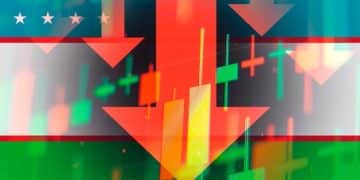Payday Lending Regulations 2025: Impact on Low-Income Credit Access

Anúncios
The new regulations on payday lending effective in 2025 are anticipated to significantly impact access to credit for low-income individuals in the US, potentially reducing predatory lending but also limiting short-term borrowing options.
The landscape of payday lending is on the cusp of significant change. As 2025 approaches, new regulations are set to reshape the industry, raising critical questions about how these changes will affect access to credit for low-income individuals in the US. Will these regulations offer much-needed protection, or will they inadvertently limit options for those who rely on short-term loans?
Anúncios
Understanding the Current Payday Lending Landscape
Payday loans have long been a controversial topic in the financial world. Before diving into the specifics of the upcoming regulations, it’s essential to understand the current environment surrounding these high-interest, short-term loans and who they primarily serve.
Payday loans are typically small-dollar loans that borrowers are expected to repay on their next payday. They are often marketed as a quick solution for unexpected expenses or financial emergencies. However, they come with notoriously high interest rates and fees, leading to cycles of debt for many borrowers.
Anúncios
Who Uses Payday Loans?
Payday loans are disproportionately used by low-income individuals who lack access to traditional banking services and credit options. These individuals may turn to payday loans out of desperation, facing immediate financial needs that cannot be met through conventional means.
- Low-Income Households: Families with limited income often use payday loans to cover basic necessities like rent, utilities, and groceries.
- Individuals with Poor Credit: Those with low credit scores may find it difficult to qualify for credit cards or bank loans, making payday loans a seemingly accessible alternative.
- Minority Communities: Studies have shown that payday lenders tend to cluster in areas with higher concentrations of minority residents, raising concerns about predatory lending practices.
The current payday lending landscape is characterized by a patchwork of state regulations, with some states imposing strict limits on interest rates and fees, while others have more permissive laws. This inconsistency creates a complex and often confusing environment for borrowers.
In conclusion, the current payday lending environment is marked by high costs, limited regulation in some areas, and a reliance on a vulnerable population. Understanding this context is crucial to assessing the potential impact of the new regulations in 2025.

Key Changes in the 2025 Payday Lending Regulations
The upcoming regulations in 2025 aim to address some of the most pressing issues associated with payday lending. It’s important to examine the specifics of these changes and how they differ from current practices.
While the exact details may vary depending on the implementing body (like the CFPB), the core objectives typically include reducing the debt trap, ensuring affordability, and increasing transparency.
Affordability Assessments
One of the primary goals of the new regulations is to ensure that borrowers can afford to repay their loans. This often involves lenders conducting affordability assessments to verify a borrower’s ability to repay the loan without re-borrowing or defaulting.
Such assessments might include verifying income, reviewing existing debt obligations, and assessing overall creditworthiness.
Restrictions on Loan Renewals and Rollovers
To prevent borrowers from becoming trapped in cycles of debt, the new regulations may place restrictions on loan renewals and rollovers. These restrictions could limit the number of times a loan can be renewed or require lenders to offer alternative repayment options.
- Cooling-Off Periods: Requiring a waiting period between loans to prevent continuous borrowing.
- Mandatory Repayment Plans: Offering borrowers the option to repay the loan in installments over a longer period.
- Principal Reduction: Requiring lenders to reduce the principal amount owed as borrowers make payments.
Furthermore, increased transparency is expected, requiring lenders to clearly disclose the terms and conditions of the loan, including interest rates, fees, and repayment schedules. This will empower borrowers to make more informed decisions.
In summary, the key changes in the 2025 payday lending regulations focus on affordability, limiting debt cycles, and enhancing transparency. These measures are intended to protect vulnerable borrowers and promote responsible lending practices.
Potential Impact on Low-Income Individuals
The new regulations on payday lending are poised to have a significant impact on low-income individuals, both positive and potentially negative. It is crucial to consider both sides to fully understand the implications.
On the one hand, the regulations could protect these individuals from predatory lending practices and reduce the risk of falling into cycles of debt. On the other hand, they could limit access to credit for those who rely on payday loans as a short-term financial solution.
Positive Impacts
The regulations could prevent borrowers from taking out loans they cannot afford, thereby reducing the risk of default and the associated financial consequences, such as damaged credit scores and collection actions.
Lowering interest rates and fees on payday loans could make them more affordable, allowing borrowers to repay their debts without sacrificing other essential needs.
Negative Impacts
Some argue that stricter regulations could lead to a reduction in the availability of payday loans, leaving low-income individuals with fewer options when faced with unexpected expenses. Alternative lending options may not be as readily accessible or may come with their own set of challenges.
- Limited Credit Options: Reduced access to short-term credit could force individuals to turn to unregulated or illegal lending sources.
- Increased Financial Hardship: Without access to payday loans, some individuals may struggle to cover essential expenses, leading to increased financial hardship.
- Unintended Consequences: The regulations may inadvertently push borrowers towards riskier or more expensive forms of credit.
It is important to monitor the actual effects of the new regulations to understand whether they are achieving their intended goals without causing unintended harm to low-income individuals. Finding the right balance between protecting borrowers and ensuring access to credit will be critical.

Alternative Credit Options for Low-Income Individuals
With new regulations potentially limiting access to payday loans, it’s important to explore alternative credit options that can serve the needs of low-income individuals. These options should be accessible, affordable, and sustainable.
Several alternatives exist, each with its own advantages and disadvantages.
Community Banks and Credit Unions
Community banks and credit unions often offer smaller dollar loans with more favorable terms compared to payday lenders. They may also provide financial education and counseling services to help borrowers manage their finances responsibly.
These institutions are typically more willing to work with individuals who have less-than-perfect credit, offering a more humane approach to lending.
Paycheck Advance Apps
Paycheck advance apps allow employees to access a portion of their earned wages before payday. These apps typically charge small fees or ask for optional tips, making them a more affordable alternative to payday loans.
- Instant Access to Funds: Provides immediate access to cash for emergencies.
- Lower Costs: Generally cheaper than payday loans, with fees often being voluntary.
- No Credit Check: Eligibility is usually based on employment and earned wages, not credit score.
Non-Profit Organizations
Various non-profit organizations offer financial assistance and small loans to low-income individuals. These organizations often provide services tailored to specific needs, such as emergency assistance, housing support, and debt counseling.
These programs aim to improve financial stability and promote self-sufficiency.
Exploring and promoting these alternative credit options is crucial to ensuring that low-income individuals have access to safe and affordable financial solutions if payday loans become less accessible due to the new regulations.
The Role of Financial Education and Counseling
Financial education and counseling play a critical role in helping low-income individuals navigate the complexities of personal finance and make informed decisions about credit. These resources can empower individuals to manage their money effectively and avoid predatory lending practices.
Education and counseling services can provide individuals with the knowledge and skills they need to build financial stability.
Budgeting and Money Management
Learning how to create a budget, track expenses, and manage debt can help individuals avoid overspending and build savings. Financial education programs often cover these essential topics, providing practical tools and strategies for effective money management.
These skills are fundamental to achieving long-term financial well-being.
Understanding Credit and Debt
Financial counseling can help individuals understand their credit scores, identify credit improvement strategies, and manage debt effectively. Counselors can provide guidance on negotiating with creditors, creating debt repayment plans, and avoiding bankruptcy.
- Credit Score Improvement: Understanding factors that impact credit scores and strategies for improvement.
- Debt Management: Developing plans to repay debts and avoid future accumulation.
- Accessing Affordable Credit: Learning how to identify and access safe and affordable credit options.
By equipping low-income individuals with the knowledge and skills they need to manage their finances responsibly, financial education and counseling can serve as a powerful tool for preventing indebtedness and promoting financial empowerment.
In conclusion, financial education and counseling are essential components of a comprehensive strategy to support low-income individuals and ensure they have access to safe, affordable credit options.
Preparing for the Future of Payday Lending
As the 2025 payday lending regulations approach, it is crucial for borrowers, lenders, and policymakers to prepare for the changes and work together to ensure a smooth transition. This involves understanding the new rules, adapting business practices, and developing support systems for vulnerable populations.
For borrowers, this means becoming informed about the new regulations and exploring alternative credit options. It also means taking advantage of financial education and counseling services to improve their financial literacy and decision-making skills. Lenders need to understand and comply with the new regulations. This may involve adjusting lending practices, developing new products, and enhancing transparency in their operations.
- Compliance with Regulations: Ensuring that all lending practices align with the new rules and requirements.
- Developing Alternative Products: Creating loan products that are affordable and sustainable for low-income borrowers.
- Enhancing Transparency: Clearly disclosing loan terms and conditions to borrowers.
Policymakers play a crucial role in monitoring the impact of the regulations and making adjustments as needed. This includes collecting data on lending patterns, assessing the effectiveness of the regulations, and addressing any unintended consequences.
Open communication and collaboration among all stakeholders are essential to ensuring that the new regulations benefit both borrowers and lenders, fostering a fair and sustainable payday lending environment.
Overall, preparing for the future of payday lending requires a proactive approach, with all parties working together to adapt to the new regulations.
| Key Point | Brief Description |
|---|---|
| 🛡️ Regulation Goals | Reduce debt traps and ensure affordable lending terms. |
| 💸 Impact on Borrowers | May decrease access to quick loans for low-income individuals. |
| 🏦Alternative Options | Community banks, credit unions, and paycheck advance apps. |
| 📚Financial Education | Essential for informed borrowing and debt management. |
FAQ
▼
The new regulations aim to reduce debt traps by ensuring affordability and increasing transparency. They may include assessments of borrowers’ ability to repay loans and restrictions on loan renewals.
▼
While intended to protect borrowers, the regulations may limit access to quick loans for those who rely on them in emergencies. This could force some to seek riskier alternatives.
▼
Alternatives include community banks and credit unions offering smaller loans, paycheck advance apps, and assistance from non-profit organizations with financial aid programs.
▼
Financial education empowers individuals to manage their finances effectively, make informed borrowing decisions, and avoid predatory lending practices, promoting long-term financial stability.
▼
Lenders should ensure compliance with the new rules, develop alternative, affordable loan products, and enhance transparency by clearly disclosing loan terms and conditions to borrowers.
Conclusion
The impending regulations on payday lending in 2025 represent a significant shift in the financial landscape for low-income individuals in the US. While these changes aim to protect vulnerable borrowers from predatory lending practices and cycles of debt, they also carry the potential to limit access to short-term credit for those who rely on it. Navigating this new environment will require a collaborative effort from borrowers, lenders, and policymakers, with a focus on financial education, responsible lending, and the development of sustainable alternative credit options. Successfully implementing these changes could lead to a more equitable and stable financial system for all.





